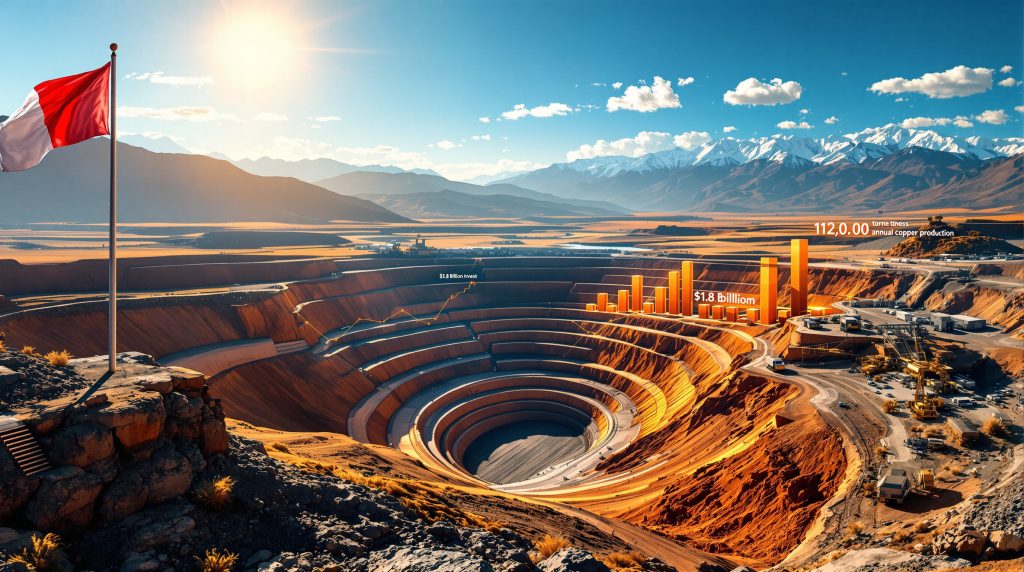Peru's Strategic Copper Development Reaches Construction Milestone
The Tia Maria copper project in Peru represents one of South America's most significant pending mining developments, marking a crucial step in Peru's strategy to maintain its position as the world's second-largest copper producer. Located in the Arequipa region, this $1.8 billion investment has reached a 23% completion milestone as of October 2025, according to Southern Copper Corporation's latest quarterly report.
The project's strategic importance extends beyond its substantial resource base, serving as a cornerstone in Peru's broader copper expansion strategy during a period of unprecedented surging copper demand. With the energy transition driving copper consumption to new heights, the Tía María development positions Peru to capitalise on long-term supply constraints while strengthening its mining infrastructure in the southern regions.
Southern Copper Corporation, controlled by Grupo México, has maintained its commitment to the 2027 production target despite historical setbacks that have delayed the project for over a decade. The company's persistence reflects both the exceptional quality of the deposit and the critical role copper plays in meeting global decarbonisation goals.
Construction Progress and Development Timeline
The Tia Maria copper project in Peru has achieved significant momentum in its construction phase, with infrastructure development proceeding across multiple fronts. The 23% completion rate encompasses essential groundwork including road construction, site preparation, and preliminary facility development that will support the full-scale mining operation.
Current workforce deployment has created 3,500 to 3,600 construction positions, providing substantial employment opportunities in the Arequipa region while building local capacity for the mining sector. This employment generation represents an immediate economic benefit even before production begins, demonstrating the project's multi-phase contribution to regional development.
The construction timeline maintains its focus on the 2027 production commencement, requiring careful coordination of multiple engineering phases. Infrastructure development priorities include:
- Transportation network improvements connecting the mine site to existing rail and port facilities
- Power transmission infrastructure to support processing operations
- Water management systems designed for both operational needs and environmental protection
- Processing plant construction for copper cathode production
- Waste management facilities aligned with environmental compliance requirements
The $1.8 billion total investment allocation spans across these construction phases, with the majority directed toward processing infrastructure and environmental mitigation systems. This investment scale positions the project among Peru's largest single-phase mining developments of the current decade.
Resource Scale and Production Specifications
The Tía María deposit contains 711 million tonnes of proven and probable reserves with an average copper grade of 0.36%, establishing it as one of Peru's most substantial undeveloped copper resources. This resource base supports a 20-year mine life encompassing both the La Tapada and Tía María deposit areas within the broader project footprint.
Annual production capacity targets 120,000 metric tonnes of copper cathodes, positioning the operation among Peru's top-tier copper producers upon reaching full production. The cathode production method offers advantages in terms of product quality and market positioning, as copper cathodes command premium pricing in global markets due to their high purity levels.
The geological characteristics of the deposit favour conventional open-pit mining methods, utilising established extraction techniques that minimise operational complexity. Furthermore, these specifications align with broader copper investment strategies that focus on technically sound projects with proven reserves.
| Technical Specification | Details |
|---|---|
| Mining Method | Conventional open-pit extraction |
| Processing Approach | Acid curing and agglomeration |
| Product Type | High-purity copper cathodes |
| Daily Processing Capacity | Optimised for 120,000 annual tonnes |
| Recovery Rates | Engineered for maximum copper extraction |
The deposit's copper grade of 0.36% represents a competitive resource quality that supports economically viable extraction over the projected mine life. This grade level, while requiring large-scale processing, ensures consistent copper production that can meet long-term supply contracts with international customers.
Historical Development Challenges and Resolution
The Tia Maria copper project in Peru has navigated a complex development timeline marked by regulatory hurdles and community engagement challenges spanning over a decade. The project's history reflects broader trends in Latin American mining regarding social licence and environmental compliance.
2011 marked the first major setback when Peru's environmental authority rejected the initial Environmental Impact Assessment, citing insufficient consultation with local communities and inadequate environmental protection measures. This rejection initiated a comprehensive review process that would reshape the project's approach to community relations.
The 2015 construction halt resulted from intensified protests by agricultural communities in the Tambo Valley, who expressed concerns about potential impacts on water resources essential for farming activities. These protests, which involved thousands of local residents, demonstrated the critical importance of community acceptance in modern mining developments.
Between 2019 and 2024, the project experienced permit revocation and subsequent reinstatement as Peru's government worked to balance development priorities with environmental and social considerations. The permit reinstatement reflected improved government support for the project following enhanced community consultation processes.
"The project's development trajectory illustrates how social acceptance has become as critical as technical feasibility in determining mining project success, particularly in regions where agriculture and mining interests intersect."
Current government support has strengthened significantly, with Peruvian authorities actively assisting Southern Copper in securing remaining administrative permits and licences. However, this support reflects Peru's recognition of the project's importance to national copper production goals and economic development objectives.
Economic Impact Projections and National Significance
The economic implications of the Tia Maria copper project in Peru extend far beyond the immediate mining operation, creating multiplier effects throughout the regional and national economy. Conservative projections estimate $17.5 billion in export revenue over the project's 20-year operational life, based on current copper price predictions and production targets.
Tax and royalty contributions are projected to reach $3.4 billion over the mine life, providing substantial revenue for both local and national government budgets. These contributions will support infrastructure development, education, and healthcare improvements in the Arequipa region while contributing to Peru's broader fiscal capacity.
Direct operational employment will create 5,400 permanent positions once production reaches full capacity, with additional indirect employment in supporting industries and services. The employment profile includes:
- Mining and processing operations: 3,200 direct positions
- Maintenance and technical services: 1,100 positions
- Administration and support functions: 1,100 positions
- Contractor and supplier jobs: Estimated 8,000+ additional positions
The project's integration with Southern Copper's existing operations at Toquepala and Cuajone mines creates synergies in logistics, processing, and technical expertise. These synergies enhance operational efficiency while providing career development opportunities for local workers across multiple mining sites.
Regional economic development will benefit from improved infrastructure, including upgraded transportation networks and enhanced power supply systems that will serve broader community needs beyond the mining operation itself.
Technical Mining and Processing Operations
The Tía María operation employs conventional open-pit mining techniques optimised for the deposit's geological characteristics and topography. The mining sequence prioritises resource recovery while maintaining operational safety standards and environmental compliance throughout the extraction process.
Processing technology centres on acid curing and agglomeration methods specifically designed for the deposit's copper mineralisation. This approach maximises copper recovery rates while minimising environmental impacts through controlled chemical processes and waste management systems.
The copper cathode production process involves multiple stages:
- Primary crushing reduces ore to manageable sizes for processing
- Secondary and tertiary crushing achieves optimal particle sizes for leaching
- Acid curing prepares the ore for copper extraction
- Heap leaching dissolves copper from the processed ore
- Solvent extraction concentrates the copper-bearing solution
- Electrowinning produces high-purity copper cathodes
Infrastructure requirements support both current operations and potential future expansion. Power supply systems connect to Peru's national grid while maintaining backup generation capacity for operational continuity. Water management systems balance operational needs with environmental protection requirements, including water recycling and treatment facilities.
Environmental monitoring systems track air quality, water resources, and biodiversity indicators throughout the operational area. These systems provide real-time data to ensure compliance with environmental standards while supporting adaptive management approaches.
Strategic Position in Peru's Copper Sector
The Tia Maria copper project in Peru strengthens the country's position as a global copper leader during a critical period of increasing demand driven by renewable energy infrastructure and electric vehicle adoption. Peru currently produces approximately 2.2 million tonnes of copper annually, ranking second globally behind Chile.
Southern Copper's integrated operations create competitive advantages through shared infrastructure and technical expertise. Consequently, the company's existing assets include:
- Toquepala mine: Long-established copper operation with expansion potential
- Cuajone mine: Major copper producer with modernised facilities
- Ilo refinery: Processing facility serving multiple mine sites
- Transportation networks: Rail and port connections for export logistics
The project's 120,000 tonnes annual production capacity represents approximately 5.5% increase in Peru's national copper output, supporting the country's goal of maintaining its global market share despite increasing competition from other producing regions.
Integration with the $10.3 billion investment pipeline across Southern Copper's Peruvian operations, including the Los Chancas and Michiquillay projects, positions the company for sustained growth over the next decade. In addition, this investment scale demonstrates confidence in Peru's mining sector stability and long-term copper demand projections.
Global market timing aligns favourably with production commencement, as global copper supply forecast indicates supply constraints are expected to intensify through the late 2020s due to limited new mine development and increasing demand from energy transition technologies.
Environmental Protection and Community Engagement
The revised Environmental Impact Assessment incorporates lessons learned from earlier community consultations and regulatory reviews. Water resource protection receives particular attention given the agricultural importance of the Tambo Valley and local concerns about potential impacts on farming activities.
Environmental monitoring protocols extend beyond regulatory requirements to include:
- Real-time water quality monitoring in surrounding watersheds
- Air quality measurement systems covering the operational area
- Biodiversity conservation programmes protecting local ecosystems
- Noise and vibration monitoring in nearby communities
- Dust control measures during construction and operations
Community benefit programmes prioritise local hiring and skills development, with commitments to source labour from surrounding municipalities where possible. Training programmes prepare local residents for mining-related employment while supporting career advancement opportunities.
Agricultural sector support initiatives acknowledge the coexistence of mining and farming in the region. These programmes include:
- Technical assistance for improved farming methods
- Infrastructure improvements benefiting agricultural communities
- Water resource management systems serving both mining and agricultural needs
- Economic development programmes supporting local businesses
Social investment commitments extend over the mine life, ensuring sustained community benefits that outlast the mining operation itself. These investments focus on education, healthcare, and infrastructure development that create lasting improvements in regional quality of life.
Future Development Potential and Industry Implications
Beyond the initial 20-year mine life, the Tia Maria copper project in Peru presents opportunities for resource expansion through additional exploration and technological improvements. The broader project area contains additional mineralisation that could extend operations subject to favourable market conditions and technological advances.
Southern Copper's broader Peruvian investment strategy positions the company for sustained growth through multiple development phases. The Los Chancas project represents another major copper development opportunity, while the Michiquillay project adds further expansion potential to the company's Peruvian portfolio.
Technology integration opportunities include:
- Automated mining equipment for improved efficiency and safety
- Advanced processing techniques for enhanced copper recovery
- Renewable energy integration to reduce operational carbon footprint
- Digital monitoring systems for optimised resource management
- Water recycling innovations for reduced environmental impact
The project's success could influence Peru's approach to other large-scale mining developments, particularly regarding community engagement and environmental protection standards. For instance, lessons learned from the Tía María experience may inform regulatory frameworks and industry best practices for future projects.
Market positioning benefits from the growing premium placed on responsibly sourced copper, as global customers increasingly prioritise environmental and social governance considerations in their supply chain decisions. The project's enhanced environmental and community programmes position it favourably for these emerging market requirements.
Global Copper Market Integration and Supply Chain Impact
The timing of Tía María's production start aligns strategically with projected copper supply deficits in the global market. Industry analysts forecast significant supply shortages beginning in the late 2020s as existing mines experience grade decline while new project development faces increasing challenges.
Peru's strategic location provides competitive logistics advantages for serving both Asian and North American copper markets. The country's established port infrastructure and trade relationships facilitate efficient export operations while minimising transportation costs compared to some competing regions.
The project's copper cathode production specifically targets high-value market segments, including renewable energy infrastructure and electric vehicle manufacturing. Copper cathodes command premium pricing due to their purity levels and immediate usability in manufacturing applications.
Supply chain integration benefits from Southern Copper's established customer relationships and marketing networks. The company's track record of reliable delivery and quality standards provides market access advantages for the new production capacity.
Long-term supply contracts are expected to secure a significant portion of production before operations begin, providing revenue certainty while supporting project financing and operational planning. These contracts typically include price adjustment mechanisms that protect against market volatility while ensuring competitive pricing.
Furthermore, the project's contribution to global supply will be significant when viewed alongside other developments such as the Argentine copper system, demonstrating South America's growing importance in meeting worldwide copper requirements.
Disclaimer: This analysis is based on publicly available information and industry projections. Copper market conditions, regulatory requirements, and project development timelines may change based on various factors including economic conditions, environmental considerations, and community relations. Readers should conduct independent research and consult with qualified professionals before making investment or business decisions related to mining operations or copper market exposure.
Ready to Capitalise on Major Copper Discoveries?
Discovery Alert's proprietary Discovery IQ model delivers real-time alerts on significant ASX mineral discoveries, instantly empowering subscribers to identify actionable opportunities ahead of the broader market. Begin your 30-day free trial today and secure your market-leading advantage in the rapidly evolving copper sector.




